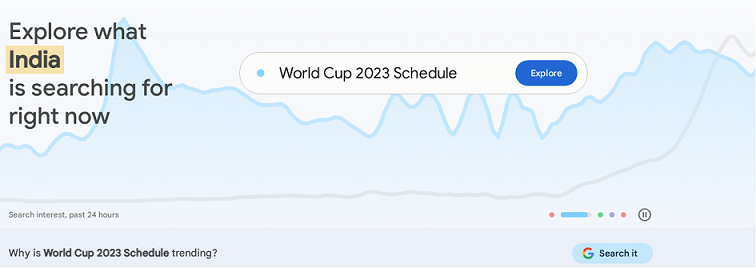Keywords play a vital role in optimizing your Etsy shop and improving its visibility on the platform. By understanding and leveraging trending keywords, you can attract more potential buyers and increase your sales. In this article, we will explore various techniques to find trending keywords on Etsy, helping you stay ahead of the competition and reach a wider audience.

I. Introduction
Etsy, a popular online marketplace for handmade and vintage products, relies heavily on effective SEO (Search Engine Optimization) techniques. Optimizing your listings with relevant keywords is crucial for ensuring your products appear in search results when potential buyers are looking for items similar to what you offer.
Finding trending keywords allows you to tap into the latest search trends and adjust your product listings accordingly. By incorporating these keywords strategically, you can increase the visibility of your listings and attract more interested buyers.
II. Understanding Etsy SEO
Before diving into the process of finding trending keywords, it’s essential to understand how Etsy’s search algorithm works and the role keywords play in optimizing your shop.
Etsy’s search algorithm takes into account various factors to determine the relevance and ranking of listings. While factors like product quality, pricing, and customer reviews are important, keywords provide the algorithm with crucial information about the content and context of your listings.
When a buyer searches for a specific item on Etsy, the algorithm scans various fields, including titles, tags, and product descriptions, to find the most relevant listings. By strategically incorporating trending keywords into these fields, you increase the chances of your products appearing higher in the search results.
III. Keyword Research Tools for Etsy
To effectively find trending keywords on Etsy, you can utilize both Etsy’s own search bar and external keyword research tools.
Etsy’s search bar itself can be a valuable resource for keyword research. Start by entering relevant terms related to your products and observe the auto-suggestions provided by Etsy. These suggestions are based on real search queries made by Etsy users, giving you insights into popular keywords and phrases.
IV. Brainstorming Relevant Keywords
To find trending keywords on Etsy, it’s important to understand your target audience and identify niche-specific keywords that resonate with them. Put yourself in the shoes of your potential buyers and brainstorm keywords that they might use when searching for products like yours.
Consider the characteristics and features of your products, as well as the benefits they offer. Think about the specific words or phrases that capture the essence of your items. These can include product attributes, materials used, design styles, or any unique selling points that set your products apart.
By conducting thorough brainstorming sessions, you can generate a list of relevant keywords that can be further refined and optimized.
V. Analyzing Competitor Keywords
Studying successful Etsy shops within your niche can provide valuable insights into the keywords they are using. Look at their product listings and identify the keywords that appear frequently. Pay attention to the titles, tags, and descriptions they use and analyze how they incorporate keywords naturally.
Additionally, examine the top-ranking listings for relevant keywords in your niche. These listings are likely optimized well and provide clues about trending keywords that are driving traffic and sales. By understanding your competitors’ keyword strategies, you can refine your own approach and find unique opportunities to differentiate your products.
VI. Utilizing Google Trends

Google Trends is a powerful tool that can help you identify popular search terms and adapt them to Etsy. By exploring trending topics and search queries related to your niche, you can discover keywords that are currently in high demand.
Enter relevant keywords related to your products into Google Trends and analyze the search volume and trend patterns. Look for keywords that show consistent or increasing popularity over time. These keywords can indicate emerging trends that you can capitalize on by incorporating them into your Etsy listings.
VII. Utilizing Etsy Trending Items
Etsy provides a “Trending Items” section that showcases popular and highly sought-after products. Explore this section and analyze the categories and keywords associated with these trending items.
By studying the keywords used in trending products, you can identify popular search terms that are currently in demand. Incorporating these keywords into your listings can help you align your products with current trends and increase your chances of attracting more buyers.
VIII. Long-Tail Keywords and Phrases
While popular keywords are important, don’t overlook the value of long-tail keywords and phrases. Long-tail keywords are more specific and have lower search volumes compared to broader, generic keywords. However, they often have higher conversion rates because they attract more targeted and qualified buyers.
For example, instead of targeting a generic keyword like “handmade necklace,” consider using long-tail keywords like “silver pendant necklace with gemstone” or “bohemian beaded necklace.” These longer and more specific phrases help you reach a more focused audience that is actively searching for exactly what you offer.
IX. Optimizing Keyword Placement
Once you have identified trending keywords, it’s crucial to strategically incorporate them into your Etsy listings. Optimize your titles, tags, and product descriptions to maximize their impact.
Place the most important and relevant keywords in your listing titles to ensure they catch the attention of both the Etsy search algorithm and potential buyers. Include additional keywords in your tags to provide further context and increase the chances of appearing in relevant search results. When writing your product descriptions, aim for a natural and engaging tone while incorporating keywords organically. Keep away from keyword stuffing, as it can negatively blow your rankings. Instead, focus on providing detailed and accurate descriptions that highlight the unique features and benefits of your products.
X. Monitoring Keyword Performance
Keyword research and optimization are ongoing processes. Continuously monitor the performance of your chosen keywords to assess their effectiveness and make necessary adjustments.
Track your keyword rankings to see how your listings are performing in search results. If certain keywords are consistently driving more traffic and conversions, focus on optimizing your listings further for those keywords. On the other hand, if certain keywords are underperforming, consider revising your strategy or replacing them with more relevant alternatives.
Analyzing keyword conversion rates is also crucial. Identify which keywords are generating the most sales or inquiries and prioritize them in your optimization efforts. By understanding which keywords are driving the highest engagement and conversion, you can allocate your resources more effectively.
XI. Adapting to Seasonal Trends

Seasonal trends play a significant role in the e-commerce industry, including Etsy. Stay updated with seasonal events, holidays, and celebrations that are relevant to your niche. Identify keywords associated with these events and incorporate them into your listings when appropriate.
For example, if you sell handmade Christmas ornaments, make sure to optimize your listings with keywords like “Christmas ornaments,” “holiday decorations,” and other relevant phrases during the festive season. By adapting to seasonal trends, you can capitalize on increased search volume and capture the attention of potential buyers during specific periods.
XII. Staying Updated with Etsy SEO Changes

Etsy’s search algorithm and SEO best practices can evolve over time. It’s essential to stay updated with any changes or updates announced by Etsy and adjust your keyword strategies accordingly.
Follow official Etsy forums, blogs, and social media channels to stay informed about algorithm updates, policy changes, and new features. Adapting to these changes promptly can give you a competitive advantage and ensure that your keyword optimization efforts remain effective.
XIII. Testing and Experimentation
In the world of SEO, testing and experimentation are key to refining your keyword strategies. Conduct A/B tests with different keywords and evaluate the results to identify the most effective ones.
Create multiple variations of your listings, each optimized with different keywords, titles, or descriptions. Monitor their performance and compare the results to determine which combinations drive the best results. Continuously refine your approach based on the insights gained from these tests to improve your Etsy SEO and attract more buyers.
XIV. Leveraging Social Media for Keyword Insights
Social media platforms provide valuable insights into popular trends, hashtags, and discussions within your niche. Monitor relevant hashtags and engage with communities related to your products to gain insights into the keywords and phrases that resonate with your target audience.
Pay attention to the language used by your potential buyers on social media platforms. Analyze their conversations, questions, and comments to identify commonly used keywords and phrases. Incorporate these insights into your keyword research and optimization strategies to better align with the interests and preferences of your target audience.
XV. Conclusion
Finding trending keywords on Etsy is a continuous and dynamic process. By leveraging various techniques such as brainstorming, analyzing competitor keywords, utilizing tools like Google Trends and Etsy’s Trending Items section, and staying updated with Etsy SEO changes, you can identify relevant and high-performing keywords for your shop.
Optimizing your listings with these trending keywords enhances your visibility, attracts more potential buyers, and increases your chances of making sales. Remember to monitor keyword performance, adapt to seasonal trends, conduct testing and experimentation, and leverage social media for additional insights.
By staying proactive and continuously refining your keyword strategies, you can position your Etsy shop for success and maximize its potential in the competitive online marketplace.
XVI. FAQs (Frequently Asked Questions)
1. Can I use multiple trending keywords in a single listing?
Yes, you can use multiple trending keywords in a listing as long as they are relevant to your product. However, ensure that the keywords are incorporated naturally and do not compromise the readability and cohesiveness of your listing.
2. How often should I update my keywords?
Keyword optimization is an ongoing process. It is recommended to review and update your keywords periodically, especially when you notice changes in search trends, competition, or the performance of your listings. Stay proactive and make adjustments as necessary to maintain the effectiveness of your keyword strategy.
3. Should I prioritize short-tail or long-tail keywords?
Both short-tail and long-tail keywords have their advantages. Short-tail keywords are more generic and have higher search volumes, but they also have higher competition. Long-tail keywords are more specific and have lower search volumes, but they attract a more targeted audience. It’s recommended to strike a balance and incorporate a mix of both short-tail and long-tail keywords in your optimization efforts.
4. Can I use trending keywords from other platforms on Etsy?
While it’s possible to take inspiration from trending keywords on other platforms, it’s important to adapt them to the context of Etsy. Consider the specific preferences and search behavior of Etsy buyers when incorporating trending keywords. Tailor your keyword strategy to align with the unique characteristics of the Etsy marketplace.
5. Should I update my keywords for every listing?
Each listing may have different target keywords based on the specific product and its attributes. While some keywords may be applicable across multiple listings, it’s important to tailor your keywords to the individual products to ensure relevance and accuracy. Take the time to research and optimize keywords for each listing to maximize its visibility and attract the right audience.
Read More:

